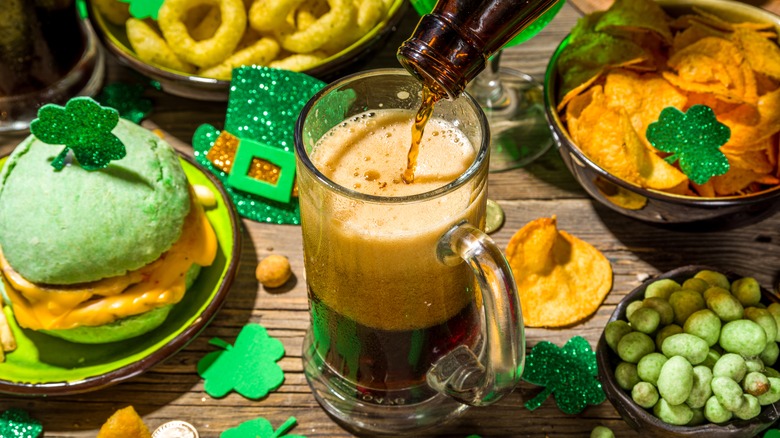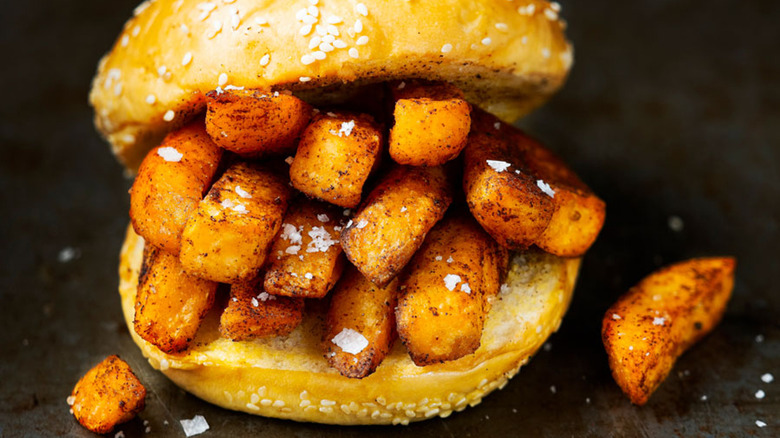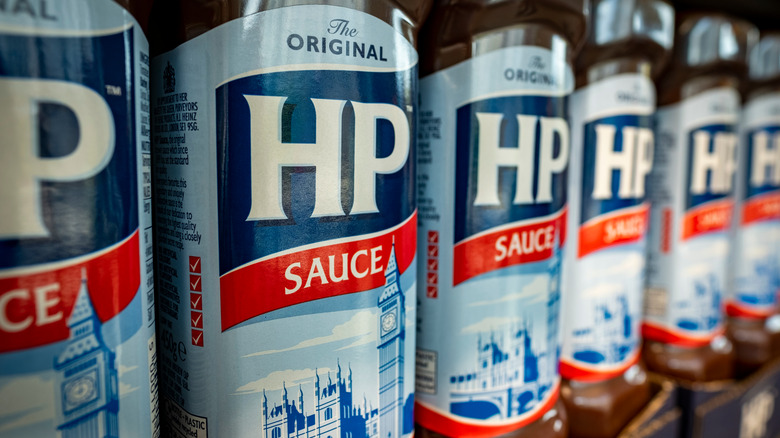A Chip Butty Is The Perfect St. Patrick's Day Food For Sandwich Lovers
It's easy to assume that if there was a patron saint of sandwiches to celebrate St. Patrick's Day, it would be the Reuben, a New York deli invention that made a good fit for an Irish-American celebration.
In Ireland, St. Patrick's Day was, in the past, a quiet day of reflection and feasting. But it may surprise you to learn that the pubs were legally closed on this day until the 1970. In the U.S., however, it became a raucous opportunity to celebrate all things Ireland. Considering over a quarter of Americans can trace some family back to the Emerald Isle, it makes sense that it's become such a big deal. That's roughly 52 million Irish-Americans, which is, per WorldOMeter, 10 times the population of Ireland.
When the Irish-American immigrants came to the U.S., they tended to land in neighborhoods with Jewish delis that featured corned beef. Salted beef wasn't a big part of Irish diets because it could fetch a higher price if shipped off to beef-loving England. Coming to a new land and finding out that corned beef was an affordable option, allowed "corned beef and cabbage" to be the meal most associated with Irish immigrants.
Reubens share both the corned beef, and the cabbage, in the form of sauerkraut, and that's why we eat Reubens on St. Patrick's Day. But, is there another sandwich that might fuel a pub crawl that's more authentically Irish?
What is a chip butty?
A chip butty is an authentically Irish sandwich that might be better for honoring St. Patrick than a Reuben. "Butty” is a term for sandwich and is probably an abbreviated form of "bread and butter." A chip butty is simply a pile of chips, AKA fries to most of us in the U.S., laying between plain, soft, white bread smeared with a generous amount of butter. Once stacked, and pushed together, the butter begins to melt and you've got an inexpensive, stick-to-your-ribs, handful of warm comfort food.
As fish and chip shops came into popularity, this humble sandwich was a part of those menus. While associated with the working classes, this sandwich crosses every demographic. There's some dispute about it originally being Irish, but even if it was invented across the Irish Sea, a chip butty has always been dependent on Ireland's potato crop.
A chip butty's simplicity is genius, but it's on the list of foods Americans just don't understand. French fries in a sandwich isn't so strange, though, in fact, Pittsburgh's sandwich scene is dominated by sandwiches topped with fries. St. Patrick's Day is the perfect time to discover a chip butty.
Chip butty upgrades
If this meal sounds bland and seems like a starchy mouthful that's tough to swallow, there is no shortage of options to upgrade a basic chip butty. First, get the chips right, unlike a long, thin, crisp French fry, chips are usually pale, broad pieces of potato that are perfect to absorb the excessive amount of butter.
There are many iterations of a chip butty. Splashing the chips with malt vinegar is a super traditional way to get the chips to the correct level of soggy along with adding notes of acidic brightness. Sauces can be divisive, but ketchup and a steak sauce, like HP, seem to be the most popular. Gravy, curry sauce, and mayonnaise work but might be frowned upon by chip butty purists.
The bread is always a basic white loaf or roll, but a chip butty can be made with a single buttered slice folded in half, with two slices, or even a club-style chip butty with a third slice between two levels of chips. No matter the construction, it's an easier-to-eat St. Patrick's Day companion. Plus, you'll get more Irish street cred scarfing a chip butty than holding a mug of green beer. It really is time to move beyond green beer.


